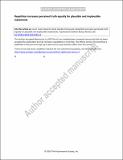| dc.contributor.author | Fazio, Lisa K. | |
| dc.contributor.author | Rand, David Gertler | |
| dc.contributor.author | Pennycook, Gordon | |
| dc.date.accessioned | 2020-11-06T21:38:12Z | |
| dc.date.available | 2020-11-06T21:38:12Z | |
| dc.date.issued | 2019-08 | |
| dc.identifier.issn | 1069-9384 | |
| dc.identifier.issn | 1531-5320 | |
| dc.identifier.uri | https://hdl.handle.net/1721.1/128421 | |
| dc.description.abstract | Repetition increases the likelihood that a statement will be judged as true. This illusory truth effect is well established; however, it has been argued that repetition will not affect belief in unambiguous statements. When individuals are faced with obviously true or false statements, repetition should have no impact. We report a simulation study and a preregistered experiment that investigate this idea. Contrary to many intuitions, our results suggest that belief in all statements is increased by repetition. The observed illusory truth effect is largest for ambiguous items, but this can be explained by the psychometric properties of the task, rather than an underlying psychological mechanism that blocks the impact of repetition for implausible items. Our results indicate that the illusory truth effect is highly robust and occurs across all levels of plausibility. Therefore, even highly implausible statements will become more plausible with enough repetition. | en_US |
| dc.publisher | Springer Science and Business Media LLC | en_US |
| dc.relation.isversionof | http://dx.doi.org/10.3758/s13423-019-01651-4 | en_US |
| dc.rights | Creative Commons Attribution-Noncommercial-Share Alike | en_US |
| dc.rights.uri | http://creativecommons.org/licenses/by-nc-sa/4.0/ | en_US |
| dc.source | Springer US | en_US |
| dc.title | Repetition increases perceived truth equally for plausible and implausible statements | en_US |
| dc.type | Article | en_US |
| dc.identifier.citation | Fazio, Lisa K. et al. "Repetition increases perceived truth equally for plausible and implausible statements." Psychonomic Bulletin & Review 26, 5 (October 2019): 1705–1710 © 2019 The Psychonomic Society, Inc. | en_US |
| dc.contributor.department | Massachusetts Institute of Technology. Department of Brain and Cognitive Sciences | |
| dc.contributor.department | Massachusetts Institute of Technology. Institute for Data, Systems, and Society | |
| dc.relation.journal | Psychonomic Bulletin & Review | en_US |
| dc.eprint.version | Author's final manuscript | en_US |
| dc.type.uri | http://purl.org/eprint/type/JournalArticle | en_US |
| eprint.status | http://purl.org/eprint/status/PeerReviewed | en_US |
| dc.date.updated | 2020-09-24T21:47:50Z | |
| dc.language.rfc3066 | en | |
| dc.rights.holder | The Psychonomic Society, Inc. | |
| dspace.embargo.terms | Y | |
| dspace.date.submission | 2020-09-24T21:47:50Z | |
| mit.journal.volume | 26 | en_US |
| mit.journal.issue | 5 | en_US |
| mit.license | OPEN_ACCESS_POLICY | |
| mit.metadata.status | Complete | |
